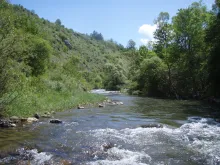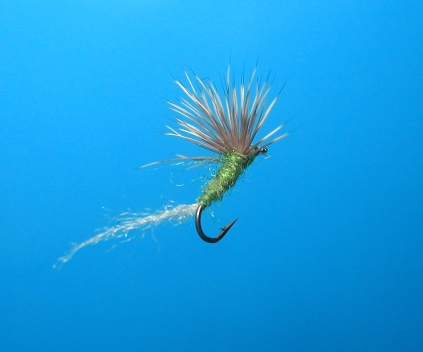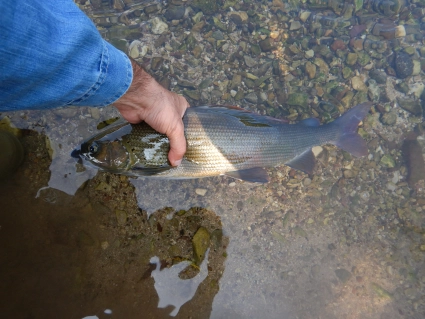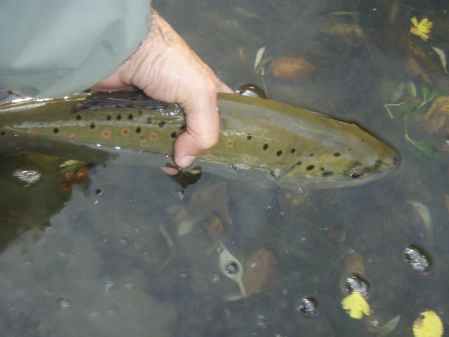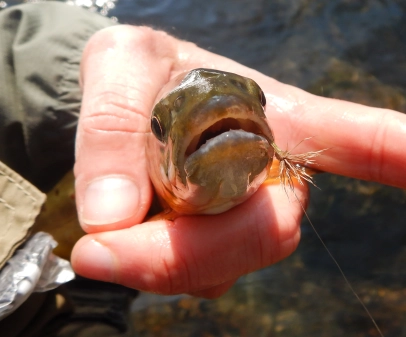Flies fitting the "Blue Winged Olive" description are important in almost every river in the trout fishing world
In his last interview Gary LaFontaine explained that the book he was writing was “Fly Fishing Blue Winged Olives", but unfortunately it was never finished.
Other authors wrote about that subject in their books: Skues in The Way of a Trout With a Fly (1921) devoted a whole chapter to BWOs. Hills in A Summer on the Test (1924) also dedicated a chapter to the BWO. The subject is obviously very significant since all later books about insects in fly fishing mention BWOs and how important they are. In recent years we became aware that this topic indeed deserves a book on its own. On almost every river in the trout fishing world the flies fitting the “Blue Winged Olive" description are important, provide good fishing and great fun for fishermen.
BWOs around the world
In our previous articles: Euro BWOs and Euro BWOs Revisited we described the way we fish for trout and grayling during the Blue-winged Olive (BWO) hatch. The history behind it was described in another article. We explained it based on our experiences with European mayfly species that belong to a BWO group (Ephemerellidae).
However, in the meantime we became aware that those mayflies exist in a much wider area than just Europe. After reading The Mayflies of Europe (Ephemeroptera) a book by Bauernfeind and Soldan, we realized that these species exist in a far larger area. For example, authors list that the original BWO (Serratella ignita) is distributed in the following area: “from the British Islands to the Amur basin including subarctic areas. Southern area limits in North Africa, Asia Minor, Mongolia, China and Korea". Another important species Ephemerella aurivillii is distributed: “In Eurasia from Scandinavia through central and northeastern Asia (south to Korea) to Japan (Hokkaido, Honshu) and the Pribil Islands in the Bering Sea. Area in North America disjunctive. Eastern subarea from Ontario to Labrador south to Pennsylvania and Michigan, western subarea from southeast Alaska south to Montana and central California". Other BWO species of European Ephemerella family are not so widely distributed, but they definitely live in a far wider area than we expected when we wrote about “Euro BWOs".
It appears that “Olive Dun" mayflies exist on almost every river inhabited with trout anywhere in the world. We knew from the American literature that there is a number of species that they call BWO. But even in places where trout were artificially planted (New Zealand, Tasmania, South America, Africa) it seems that some Olive Duns exist. This explains the statement made by Tom Rosenbauer that he would not go anywhere in the world without a BWO imitation. He was talking about dry fly imitation, because it has to be specific to obtain good results. Imitating BWO nymphs is quite easy, any of the numerous Pheasant’s Tail Nymphs will do and also all of the bead head patters we mentioned in previous articles. In this text we will deal with appropriate dry flies as BWO imitations
The influence of river geology on dry fly fishing
Rosenbauer explained that geology defines the nature of a trout stream and that calcium content is important for abundance of its life. He divided rivers into three categories: 1. spring creeks (very rich in calcium), 2. freestone rivers flowing through various rocks (moderately rich in calcium), and 3. rain fed freestone rivers flowing though silicate rocks like granite, sandstone and similar (poor in calcium). Tailwater rivers, below dams are a special group (4), which can be very rich in trout food. It is important to understand the differences between these river types because they have a great influence on the type of flies that are successful as trout food imitation.
The type of river dictates the type of fly to be used, both in terms of construction and size. Water levels also dictate the type and size of the fly. Small and delicate flies are usually used on spring creeks, which look like the insects the trout is eating. The successful fly must be very close to natural insects in terms of size, shape and color – and must be presented in a natural manner. If one of those parameters is not correctly matched the fish will not accept the fly. There is great diversity between flies that can be suitable for fishing on rivers type 2 and 3, and those successful on the rivers of the type 1. Floating flies for faster and more turbulent are more massive and scruffy than those used for smooth limestone rivers. They are built that way so that they can float better and the fast water hides their faults as insect imitations. On the other hand, the flies used on the rivers of type 1 are smaller and more delicate.
|
|
|
|
|
|
|
|
|
|
|
|
The imitative (matching the hatch) school teaches us that we need a very close imitation of all insect features for a fly to be successful. The impressionistic school believes that it is enough to get the GISS (general impression, shape and size) in a fly to catch a trout. However our observations show that neither is really necessary aside from a general impression and appropriate size (which is not necessarily the same as the insect size). Many experts tell or write that if a fish is refusing an imitation we should try a smaller fly of the same pattern. This is generally good advice based on experience. But there is no explanation why fish sometimes prefer a fly that is smaller than the natural insect to the one that has the exact size. The fact that sometimes we need a bigger fly is almost never mentioned, although such episodes do happen.
Matching the BWO hatch with a dry fly
How does this apply in matching the BWO hatch? BWOs appear on all types of rivers, but their abundance is not the same. The hatches are much richer on spring creeks (type 1). The number of insects depend on available nutrients, so the richer the river is the larger BWO hatches are. The average size of Serratella ignita can be imitated with flies tied on hooks 16 and 18. On rivers of the type 1 the most effective imitation are No-hackle CDC Dun and Shuttlecock Emerger in sizes from 18 to 24. On the rivers of the type 2 we had the best results with Sparkle Dun in sizes 16 and 18. Finally on rivers of the type 3 we had the best results with Hackle BWO in size 14 and 16. The rivers of the type 4 are somewhere between 1 and 2, which depends on the nature of their valley. It is possible to fish on the river type 3 with flies we mentioned for type 1, but it is hard to see those delicate flies size 18 or 20 on the rippled water. However, if you try to use bushier Hackle BWO on a river of the type 1 you would probably catch nothing even in a very dense hatch.
The type and size of a successful fly also depends on the water level in the river. For example, fish may take a larger and bushier fly in higher water than when the water is low. It is normal to see that BWO imitations that catch fish are smaller and smaller as the season advances, and not necessarily because the insects get smaller, although that also can be the case. Even on spring creeks it is possible to fish successfully with hackle and deer hair flies when the water is high and more turbulent. On the other hand, on calmer parts of freestone rivers in low water conditions sometimes only CDC imitations would work.
| River type | Flies |
| 1. spring creeks | No-hackle CDC Duna CDC Stuck Dun Shuttlecock Emerger |
| 2. freestone rivers | Deer Hair Stuck Dun Sparkle Dun |
| 3. rain fed freestone rivers | Hackle BWO Deer Hair Stuck Dun |
All of the above mentioned flies were described in our previous texts, but there is one pattern that needs special comment. Actually it is a fly we already mentioned as Olive Thread BWO CDC Emerger, which in the meantime became more important as a general BWO imitation. We observed that during the summer BWO hatches there is a great number of duns that managed to leave the nymphal shuck but after that became stuck in the water surface film. In his excellent video Don Stazicker calls them Casualty Duns. So basically they do not have hanging shuck as emergers. They look like ordinary duns that are a bit messy and unable to fly. This phenomenon may be connected with high air temperature in the summer, but we observed it also in the late autumn when LDOs were hatching. Fish always prefer easy prey, and the flies which imitate such a situation are quite successful. Since we and our friends caught a great number of trout and grayling on those flies, they became the regular first choice for fishing the BWO hatch. We decided to simplify its name and call it Stuck Dun, which also more precisely describes what it actually imitates. We are tying it with deer hair wings for higher water and with CDC wings for lower and quieter water. It is an extremely simple fly, just body and wings, but fish take it with great confidence. A CDC version looks like a reversed F Fly, while the deer hair version looks like a slimmed down Wyatt’s DH Emerger. But in our experience those flies, especially Wyatt’s rather fat bodied pattern, are not even closely successful during the BWO hatch compared to the Stuck Dun.
Casualties
There is a lot of such crippled insects AKA casuals, and they come in many various shapes. Trout and grayling prefer to eat them since they are mosty stuck in the surface and unable to fly off. They certainly don’t need a hyper realistic imitation and we have fooled a large number of fish on the simple fly that we call Stuck Dun.
The BWO spinner fall is also a time for a fine dry fly action. We mentioned earlier various successful patterns and this time we will only indicate that various versions of Pheasant’s Tail dry fly can be quite successful when the situation occurs.
We are fortunate to fish a spring creek where BWO (Ephemerellidae) hatches are very abundant starting in April and ending in October. Aside from few moments BWO is the most important food item for trout and grayling that live there. So we are able to fish the same hatch in various conditions, especially in all kinds of water levels, from high and turbulent in spring to very low and calm in the autumn. During the rest of the year the Large Dark Olive (LDO, Baetis rhodani) is the most important hatch on the same river. Although LDO has a significantly darker olive body than BWO it is possible to catch fish (grayling season is open in the autumn and winter) with the same patterns in appropriate sizes. There is a period in spring and late autumn when the two flies overlap and hatch simultaneously. But this does not create a problem in pattern selection. We use the flies described in this and previous articles, just paying attention to the water level, choosing larger and bushier flies in the spring. The size decreases as the season advances and the flies become more delicate – the smallest we use in late October and November.
Hand picked for this article
- Log in to post comments








